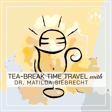
Lascaux Cave: the original tattoo studio - Ep 20
There are so many things that don’t survive the thousands of years between the past and present, and so many crafts and skills that are very difficult to identify from a material point of view. Luckily, we have expert artists who can help us out! This month, Matilda is joined by professional tattoo artist Daniel Riday, who will be chatting all about the tools and techniques used in ancient tattooing. What’s the difference between using a blade versus a needle to create a tattoo? What’s the oldest tattooing tool ever found? Are we really sure we know how Ötzi the Iceman got his tattoos? And why does Daniel want to mummify himself? Tune in to find out in the first of this exciting two-part special on the fascinating subject of ancient tattoos.
Links
- EXARC tattooing project
- EXARC tattooing project published paper
- Chauvet cave paintings
- Lascaux cave paintings
- Maya Sialuk Jacobsen (Inuit tattoo traditions)
- Terra Metis Ceramics
Guest Contact:
- Name: Daniel Riday
- Insta: @totemic_tattoo
Contact the Host
- Email: matilda@thearchaeologiststeacup.com
- https://www.thearchaeologiststeacup.com
- insta: @the_archaeologists_teacup
- fb: /TheArchaeologistsTeacup
- twitter: @ArchaeoTeacup
ArchPodNet
- APN Website: https://www.archpodnet.com
- APN on Facebook: https://www.facebook.com/archpodnet
- APN on Twitter: https://www.twitter.com/archpodnet
- APN on Instagram: https://www.instagram.com/archpodnet
- Tee Public Store: https://www.teepublic.com/stores/archaeology-podcast-network?ref_id=5724
Affiliates
- Motion: https://www.archpodnet.com/motion
- Liquid I.V. Ready to shop better hydration, use my special link https://zen.ai/thearchaeologypodnetworkfeed to save 20% off anything you order.
